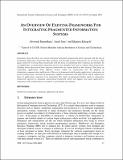| dc.contributor.author | Ramadhani, Abswaidi | |
| dc.contributor.author | Sam, Anael | |
| dc.contributor.author | Kalegele, Khamisi | |
| dc.date.accessioned | 2023-11-01T08:40:50Z | |
| dc.date.available | 2023-11-01T08:40:50Z | |
| dc.date.issued | 2016-11 | |
| dc.identifier.uri | 10.5121/ijist.2016.6602 | |
| dc.identifier.uri | https://dspace.nm-aist.ac.tz/handle/20.500.12479/2395 | |
| dc.description | A research article was submitted by International Journal of Information Sciences and Techniques (IJIST) Vol.6, November 2016 | en_US |
| dc.description.abstract | Literatures show that there are several structured integration frameworks which emerged with the aim of facilitating application integration. But weakness and strength of these frameworks are not known. This paper aimed at reviewing these frameworks with the focus on identifying their weakness and strength. To accomplish this, recommended comparison factors were identified and used to compare these frameworks. Findings shows that most of these structure frameworks are custom based on their motives. They focus on integrating applications from different sectors within an organization for the purpose of eliminating communication inefficiencies. There is no framework which guides application’s integrators on goals of integrations, outcomes of integration, outputs of integration and skills which will be required for types of applications expected to be integrated. The study recommended further study on integration-framework especial on designing unstructured framework which will support and guide application’s integrators with consideration on consumer’s surrounding environment | en_US |
| dc.language.iso | en | en_US |
| dc.publisher | International Journal of Information Sciences and Techniques (IJIST | en_US |
| dc.subject | Framework | en_US |
| dc.subject | application & system | en_US |
| dc.title | An overview of existing frameworks for integrating fragmented information systems | en_US |
| dc.type | Article | en_US |

